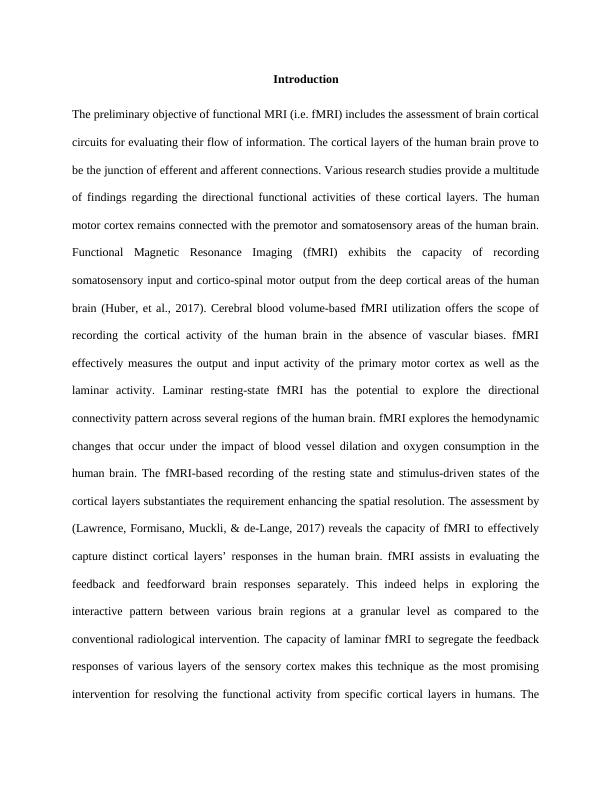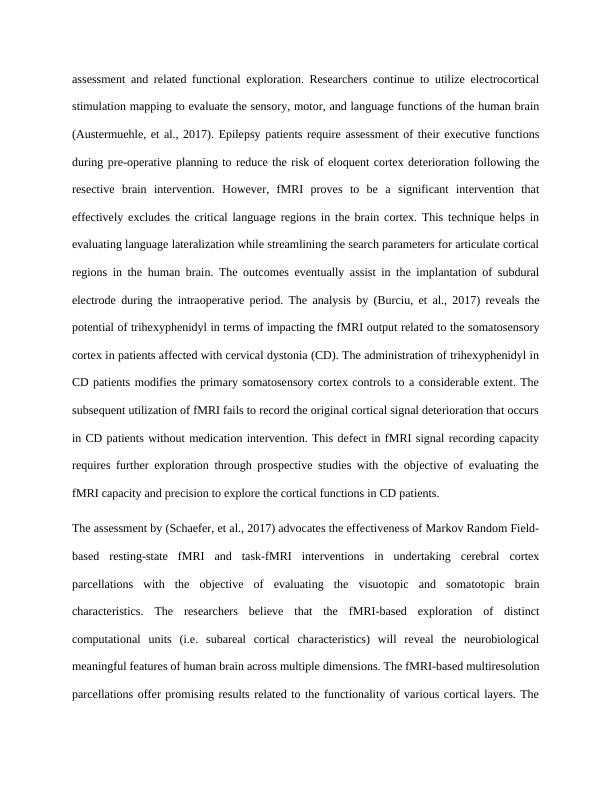Functional MRI (fMRI) for Resolving Cortical Layers' Functional Activity in Humans
Added on 2023-06-11
14 Pages3812 Words132 Views
6/9/2018

Introduction
The preliminary objective of functional MRI (i.e. fMRI) includes the assessment of brain cortical
circuits for evaluating their flow of information. The cortical layers of the human brain prove to
be the junction of efferent and afferent connections. Various research studies provide a multitude
of findings regarding the directional functional activities of these cortical layers. The human
motor cortex remains connected with the premotor and somatosensory areas of the human brain.
Functional Magnetic Resonance Imaging (fMRI) exhibits the capacity of recording
somatosensory input and cortico-spinal motor output from the deep cortical areas of the human
brain (Huber, et al., 2017). Cerebral blood volume-based fMRI utilization offers the scope of
recording the cortical activity of the human brain in the absence of vascular biases. fMRI
effectively measures the output and input activity of the primary motor cortex as well as the
laminar activity. Laminar resting-state fMRI has the potential to explore the directional
connectivity pattern across several regions of the human brain. fMRI explores the hemodynamic
changes that occur under the impact of blood vessel dilation and oxygen consumption in the
human brain. The fMRI-based recording of the resting state and stimulus-driven states of the
cortical layers substantiates the requirement enhancing the spatial resolution. The assessment by
(Lawrence, Formisano, Muckli, & de-Lange, 2017) reveals the capacity of fMRI to effectively
capture distinct cortical layers’ responses in the human brain. fMRI assists in evaluating the
feedback and feedforward brain responses separately. This indeed helps in exploring the
interactive pattern between various brain regions at a granular level as compared to the
conventional radiological intervention. The capacity of laminar fMRI to segregate the feedback
responses of various layers of the sensory cortex makes this technique as the most promising
intervention for resolving the functional activity from specific cortical layers in humans. The
The preliminary objective of functional MRI (i.e. fMRI) includes the assessment of brain cortical
circuits for evaluating their flow of information. The cortical layers of the human brain prove to
be the junction of efferent and afferent connections. Various research studies provide a multitude
of findings regarding the directional functional activities of these cortical layers. The human
motor cortex remains connected with the premotor and somatosensory areas of the human brain.
Functional Magnetic Resonance Imaging (fMRI) exhibits the capacity of recording
somatosensory input and cortico-spinal motor output from the deep cortical areas of the human
brain (Huber, et al., 2017). Cerebral blood volume-based fMRI utilization offers the scope of
recording the cortical activity of the human brain in the absence of vascular biases. fMRI
effectively measures the output and input activity of the primary motor cortex as well as the
laminar activity. Laminar resting-state fMRI has the potential to explore the directional
connectivity pattern across several regions of the human brain. fMRI explores the hemodynamic
changes that occur under the impact of blood vessel dilation and oxygen consumption in the
human brain. The fMRI-based recording of the resting state and stimulus-driven states of the
cortical layers substantiates the requirement enhancing the spatial resolution. The assessment by
(Lawrence, Formisano, Muckli, & de-Lange, 2017) reveals the capacity of fMRI to effectively
capture distinct cortical layers’ responses in the human brain. fMRI assists in evaluating the
feedback and feedforward brain responses separately. This indeed helps in exploring the
interactive pattern between various brain regions at a granular level as compared to the
conventional radiological intervention. The capacity of laminar fMRI to segregate the feedback
responses of various layers of the sensory cortex makes this technique as the most promising
intervention for resolving the functional activity from specific cortical layers in humans. The

intervention like fMRI might also assist in evaluating the neural causes of synaesthesia through
cortical assessment in the human population (Ramachandran & Hubbard, 2001). fMRI is a
systematic technique that provides excellent temporal resolution and non-invasively performs
cortical assessment in the absence of radiation. The unique functionality of fMRI expands its
scope of utilization for evaluating the physiology of cortical layers in human brain. Presented
argumentative essay critically examines various arguments in favour of and against the fMRI
application in the functional assessment of these cortical layers. The essay also recommends
various strategies and approaches to mitigate the controversies related to the fMRI implications
on the functional evaluation of the human brain.
fMRI extends applications in the brain circuitry assessment interventions used to evaluate the
response of the autonomous nervous system against nausea. Indeed, nausea leads to elevation in
the sympathetic response and a reduction in parasympathetic response that leads to the decrease
in cardiac function and enhancement of the cardiac rate (Kim, Napadow, Kuo, & Barbieri, 2012).
Positive correlations between fMRI signals in the pregenual anterior cingulate cortex, medial
prefrontal cortex, and elevated cortical/emotional function locations at the time of nausea
indicate the impact of motion sickness on the cardiovagal modulation cortical control in the
human brain. The study by (Kim, Napadow, Kuo, & Barbieri, 2012) reveals the capacity of fMRI
in terms of evaluating the nausea-based sympathovagal shift that occurs under the impact of
brain activity across the areas that handle the significant functions like higher cognitive function
and emotion. The nausea-based cardiovagal modulation varies in accordance with the functional
impact of effective, cognitive, and interceptive brain regions. fMRI assists in evaluating the
autonomic nervous system response of the cortical layers of the brain circuitry during nausea
episode. These evidence-based findings affirm the effectiveness of fMRI in brain’s cortical
cortical assessment in the human population (Ramachandran & Hubbard, 2001). fMRI is a
systematic technique that provides excellent temporal resolution and non-invasively performs
cortical assessment in the absence of radiation. The unique functionality of fMRI expands its
scope of utilization for evaluating the physiology of cortical layers in human brain. Presented
argumentative essay critically examines various arguments in favour of and against the fMRI
application in the functional assessment of these cortical layers. The essay also recommends
various strategies and approaches to mitigate the controversies related to the fMRI implications
on the functional evaluation of the human brain.
fMRI extends applications in the brain circuitry assessment interventions used to evaluate the
response of the autonomous nervous system against nausea. Indeed, nausea leads to elevation in
the sympathetic response and a reduction in parasympathetic response that leads to the decrease
in cardiac function and enhancement of the cardiac rate (Kim, Napadow, Kuo, & Barbieri, 2012).
Positive correlations between fMRI signals in the pregenual anterior cingulate cortex, medial
prefrontal cortex, and elevated cortical/emotional function locations at the time of nausea
indicate the impact of motion sickness on the cardiovagal modulation cortical control in the
human brain. The study by (Kim, Napadow, Kuo, & Barbieri, 2012) reveals the capacity of fMRI
in terms of evaluating the nausea-based sympathovagal shift that occurs under the impact of
brain activity across the areas that handle the significant functions like higher cognitive function
and emotion. The nausea-based cardiovagal modulation varies in accordance with the functional
impact of effective, cognitive, and interceptive brain regions. fMRI assists in evaluating the
autonomic nervous system response of the cortical layers of the brain circuitry during nausea
episode. These evidence-based findings affirm the effectiveness of fMRI in brain’s cortical

assessment and related functional exploration. Researchers continue to utilize electrocortical
stimulation mapping to evaluate the sensory, motor, and language functions of the human brain
(Austermuehle, et al., 2017). Epilepsy patients require assessment of their executive functions
during pre-operative planning to reduce the risk of eloquent cortex deterioration following the
resective brain intervention. However, fMRI proves to be a significant intervention that
effectively excludes the critical language regions in the brain cortex. This technique helps in
evaluating language lateralization while streamlining the search parameters for articulate cortical
regions in the human brain. The outcomes eventually assist in the implantation of subdural
electrode during the intraoperative period. The analysis by (Burciu, et al., 2017) reveals the
potential of trihexyphenidyl in terms of impacting the fMRI output related to the somatosensory
cortex in patients affected with cervical dystonia (CD). The administration of trihexyphenidyl in
CD patients modifies the primary somatosensory cortex controls to a considerable extent. The
subsequent utilization of fMRI fails to record the original cortical signal deterioration that occurs
in CD patients without medication intervention. This defect in fMRI signal recording capacity
requires further exploration through prospective studies with the objective of evaluating the
fMRI capacity and precision to explore the cortical functions in CD patients.
The assessment by (Schaefer, et al., 2017) advocates the effectiveness of Markov Random Field-
based resting-state fMRI and task-fMRI interventions in undertaking cerebral cortex
parcellations with the objective of evaluating the visuotopic and somatotopic brain
characteristics. The researchers believe that the fMRI-based exploration of distinct
computational units (i.e. subareal cortical characteristics) will reveal the neurobiological
meaningful features of human brain across multiple dimensions. The fMRI-based multiresolution
parcellations offer promising results related to the functionality of various cortical layers. The
stimulation mapping to evaluate the sensory, motor, and language functions of the human brain
(Austermuehle, et al., 2017). Epilepsy patients require assessment of their executive functions
during pre-operative planning to reduce the risk of eloquent cortex deterioration following the
resective brain intervention. However, fMRI proves to be a significant intervention that
effectively excludes the critical language regions in the brain cortex. This technique helps in
evaluating language lateralization while streamlining the search parameters for articulate cortical
regions in the human brain. The outcomes eventually assist in the implantation of subdural
electrode during the intraoperative period. The analysis by (Burciu, et al., 2017) reveals the
potential of trihexyphenidyl in terms of impacting the fMRI output related to the somatosensory
cortex in patients affected with cervical dystonia (CD). The administration of trihexyphenidyl in
CD patients modifies the primary somatosensory cortex controls to a considerable extent. The
subsequent utilization of fMRI fails to record the original cortical signal deterioration that occurs
in CD patients without medication intervention. This defect in fMRI signal recording capacity
requires further exploration through prospective studies with the objective of evaluating the
fMRI capacity and precision to explore the cortical functions in CD patients.
The assessment by (Schaefer, et al., 2017) advocates the effectiveness of Markov Random Field-
based resting-state fMRI and task-fMRI interventions in undertaking cerebral cortex
parcellations with the objective of evaluating the visuotopic and somatotopic brain
characteristics. The researchers believe that the fMRI-based exploration of distinct
computational units (i.e. subareal cortical characteristics) will reveal the neurobiological
meaningful features of human brain across multiple dimensions. The fMRI-based multiresolution
parcellations offer promising results related to the functionality of various cortical layers. The

End of preview
Want to access all the pages? Upload your documents or become a member.
